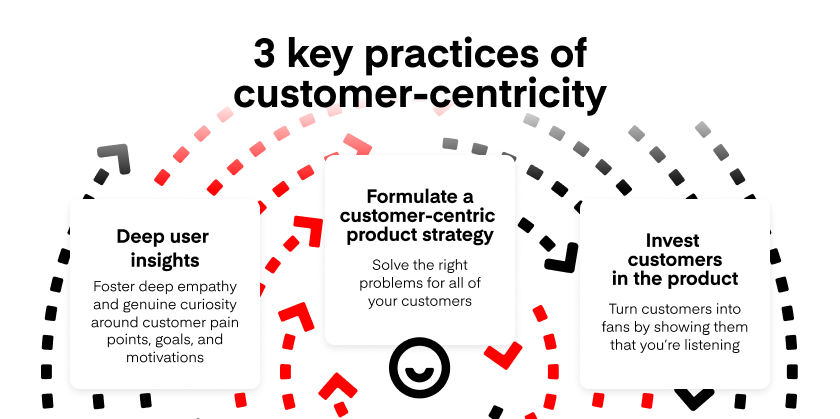Making a product is easy. Making a product that your customers LOVE is hard. Or is it Let’s take a look at the top 10 ways to master customer-centric product development and put your customers in a position where they can’t help but return to your product.
But first, what do we mean by customer-centric product design?
Customer-Centric Product Design
Customer-centric product design is exactly what it says on the tin. It’s a way of designing a product that is customer oriented. Essentially, you build for your users rather than find users for something you’ve built. It’s a way of keeping the customer in mind throughout the entire product development phase.

Source: Productboard.
According to Productboard, there are 3 key practices to keep in mind for customer-centricity:
- Deep user insights
- Formulate a customer-centric product strategy
- Invest customers in the product
Deep User Insights
To “foster deep empathy and genuine curiosity around customer pain points, goals and motivations”, your team must interact with customers whenever possible, carefully watch them as they use your product, and set up a UX research repository so that insights can be shared and accessed easily by anyone in the company. Ideally, everyone in the business should be encouraged to participate, fostering a work-culture around sharing insights.
Customer-Centric Product Strategy
To solve your customers’ problems, you’ll first need to understand what they need. This neccessitates undertaking a lot of user research and forming a customer-centric prioritization framework. Basically, create a balance between breaking boundaries with new innovations, and fixing pain points of the user.
Invest Customers in the Product
While we haven’t yet mastered the arts of alchemical transmutation, we’re lucky in that turning customers into returning customers is actually quite simple in comparison. You simply listen to what they’re saying and make the necessary adjustments. Keep them updated with what’s in the pipeline and let them in on your product vision – this will help you earn emotional buy-in.
Customer-Centric Product Management
So, how do you turn these three key practices into a quality product that customers can’t get enough of?
Here are ten tips to help you implement the customer’s needs into your design process.
10 Ways to Master Customer-Centric Product Development
1. Make User Insights Accessible
One of the most fundamental things you must do for your business is make your user insights easily accessible to everyone. You might have the best user insights in the world, but if your stakeholders can’t access them, then what’s the point? If your product designers don’t understand what the user wants because the user researchers weren’t able to convey the customer’s thoughts in the right manner, then your product will never be customer-centric.
The best research repositories are those that can be accessed by your entire team. They shouldn’t be difficult to learn or understand. This will give you the power of knowing what the customer thinks and needs, something that ALL businesses should have, especially if their focus is on customer-centric product design.
tl;dv
tl;dv is the remote UX research tool to use if you’re wanting to document your research in a more accessible manner. It allows you to pluck insights straight from the horse’s mouth and convert them into short clips that can be shared with a simple copy and paste. Now, user researchers can collect a bunch of short highlights from their user interviews, and share them instantly with decision makers so they can hear the concern or praise directly from the voice of the customer.
There’s no room for bias. There’s no room for sloppy notes or unemotional action points. There’s no room for anything but the cold, hard truth.

Plus, as a free online meeting recorder with unlimited recordings, transcripts, timestamps, editing, and the ability to tag colleagues – tl;dv is the perfect tool for keeping track product meetings. You can access your meetings library to search through any Google Meet or Zoom call, easily locating past sprint reviews, plannings, bug reports, decisions, and more.
Did we mention all these features are completely free…forever!?
2. Don’t Rely on Your Product Roadmap
Product roadmaps are a great thing to have, don’t get me wrong! But sometimes, they’re a tad overrated. When it comes to customer-centricity, that ‘sometimes’ becomes an ‘always’.
Just think: if your customer is pleading with you to go one way, but you’re stuck on your rigid roadmap, then your customer is gonna end up unhappy, and you’ll end up with a product you envisioned from the start, only it’ll have no users. Customers are everything.
To put it simply: let your roadmap go and listen to your customers. You’ll both be better off.
3. Document User Insights Accurately
Similarly to the first point about accessibility, user insights are only as valuable as the way they are documented. While there are dozens of popular documentation tools that you can use for such a job, there are some things to keep in mind first.
Your user insights should do 3 things:
- Be accessible
- Be skimmable
- Tell the whole picture with evidence
Accessibility was already addressed as the primary point on this list, because, quite frankly, without it you’d be toast. The rest wouldn’t even matter.
To be skimmable, your user insights need to be on a documentation tool that is easy to organize, and preferably visual. It’s far easier to skim something more visually appealing than a big-ass wall of text. Use headings to break it up, or perhaps make the important parts bold.

To tell the whole picture with evidence, you need unbiased evidence. By using tl;dv to record, transcribe, and create short clips of your user interviews, you will tick all three boxes: accessible, skimmable, and backed up with evidence.
Try it out on Google Meet or Zoom for free today.
4. Employ Customer-Centric Framework
For customer-centric product management, you need to be using the right framework. We think Jobs-To-Be-Done is the bees knees and if you’re clueless when it comes to framework, then you should start here.
Adopting this type of framework will give you:
- Improved customer insight – deeper insights into why customers purchase certain products and how they use them in different contexts
- Increased product effectiveness – improve upon your current product after thoroughly understanding the customer’s motivations
- Faster innovation cycles – understanding what your customers want empowers you to cut the crap and get on with it quicker
- More customer loyalty – by providing a solution to a customer’s needs, he becomes satisfied. When this happens across the board, you’ll maximize customer loyalty
Whichever framework you employ, make sure it’s a customer-centric one.
5. Open Your Mind

When you approach a task with an open mind – or anything for that matter – you allow your programming to fall out. Most of the time, this is a good thing. Imagine talking with your customers, and truly understanding what they have to say; their wants, needs, and hopes. With an open mind, you can access this raw data as simply as just asking them the right questions.
By approaching the task without bias, you can mine away at all the nuggets you can get. This way, the customer will shape the product.
Don’t enter the conversation as the big know-it-all who thinks they understand the customers’ pain points and preferences. Let the user do the talking, record it with tl;dv, and then share the best clips with your stakeholders so they can hear the exact same thing that you did.
For the best results, employ a user interview style such as the Mom Test. In fact, this is essential to get the most crucial information out of your users. If you can get good feedback from your mom, then why not use the same technique to get great feedback from your actual users?
Bad research is worse than doing no research at all.
6. Stay Up-To-Date
Customer-centric product design is constantly shifting. New thought leaders create new paradigms. New innovations pave the way for new inventions. By staying up to date with your field of expertise, you’ll be able to keep your place at the pinnacle of innovation.
If you’re looking for some top-notch product manager books to read, then look no further than our 2023 reading list.
You can also follow your favorite authors or speakers or designers on social media and listen to what they have to say. They’ll often drop raw knowledge that you can use to improve upon your process.

7. Diversify, Diversify, Diversify!
No, we’re not talking about trading portfolios here. We’re talking about the sources for interacting with your customer. For example, you don’t want to just get your customer info from Amazon reviews. Similarly, you don’t want to get them purely from user interviews. The best process is one that holistically integrates all interactions with the customer into one bonafide plan of action.
While diversification should also be taken on the granular level, like when selecting participants for your user interviews, it should also be implemented in the range of sources from which you can gain product-changing knowledge.
Here are some ways that you can diversify the way you get information from your customers:
- Get G2 reviews from your own tools and competitors
- Listen to support conversations
- Go on Reddit
- Jump on user calls
- Implement an NPS survey
- Use usability tracking apps and other user research tools
- Talk face-to-face (like in the good ol’ days)
The more ways you can source information from your users, the better.
8. Have Product Managers Work Support Cases
The quickest way for a product manager to truly understand the pain points of the user is to work on support cases with the customer support team. When they hear the struggles of the user, they should be able to relate better and understand how to make a significant change that will make everyone’s lives easier.
This is especially worthwhile if it’s your first month on the job and you need to get a feel for what the users feel fast, or if you’ve recently released a new feature or overhauled the UX.
9. Accountability
Get your customer support team and your product team to hold each other accountable. If the product team isn’t addressing the biggest pain point of the user, then the customer support team has to let them know ASAP with irrevertible proof (another reason why the entire team should be able to access and add to the research repository).
Similarly, if the support team doesn’t vocalize common issues effectively then they’re not going to be addressed. It’s a two-way street and there absolutely needs to be collaboration there to make it work.
Set up channels to collect feedback from support teams and ensure that it doesn’t get lost, ignored, or forgotten.
To close the loop, when the product team has fixed a common pain point, the customer support team should inform the user, letting them know that their word has been valued and acted upon. This will increase user loyalty and let them know that they made a positive difference.
10. Use tl;dv’s Product Community
Introducing tl;dv’s Product Community, an anonymous space to get unbiased support and advice on your product.
We know that it can be difficult to keep your product aligned with the needs of your customer, but this space is completely open for you to vent, ask questions, or get advice from other product-minded peeps.
Pop by for day-to-day product questions, struggles, rants, and advice.
You can also get tl;dv, the product research software, for recording, transcribing, and creating short highlights of your user research in seconds.





